Coal hood: types, device, selection and installation rules
Not only total ventilation will help get rid of annoying aromas spreading throughout the house/apartment during the process of preparing dishes in the kitchen.
A charcoal hood will be an excellent helper in such a situation - it will effectively purify the air, saturated with the aromas of fried chicken, garlic dressing and seasoned with the sweetish aroma of baking chocolate biscuit. What else the equipment can do and how it works - we’ll talk about this in our article.
We will also discuss the design of this type of kitchen hood, dwell on the intricacies of choice, consider the installation features and provide useful recommendations for caring for the equipment.
The content of the article:
Design and features of coal exhaust
You can find conflicting opinions about coal hoods - from total respect to complete contempt. Opponents believe that no filter can cope with annoying kitchen aromas. And maintenance of a device with carbon filters will cost a pretty penny. A closer acquaintance with this technique will help to defeat these beliefs.
Is a carbon filter necessary?
A common feature in the kitchen is a powerful hood with an air duct. It is she who is able to quickly remove exhaust air from the room, preventing it from spreading into adjacent rooms, provided correct choice of power.
But the air does not have to be evacuated from the kitchen - it can be purified using devices with a fine filter.
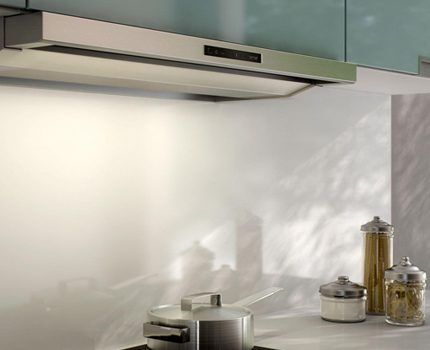
It is against the hood with carbon filters Many skeptics rebel, believing that she is in no way capable of coping with the task. And all arguments to the contrary are nothing more than advertising.
In fact, such a hood has repeatedly proven that it has the right to be used not only in private houses and apartments, but also in professional kitchens of restaurants, cafes and other premises where it is necessary to effectively purify exhaust air from impurities.
Not only does the device perfectly remove odors, but it is also easy to install and requires minimal maintenance. Moreover, all this, if desired, can be easily done independently - you don’t have to drill or break anything.
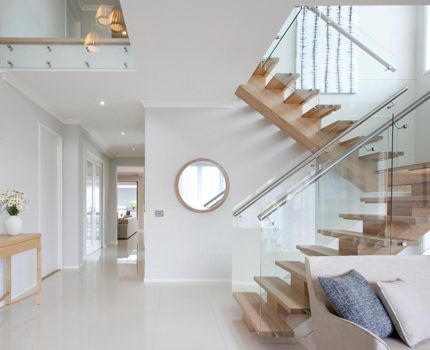
Another advantage is the wide price range. Hoods that rid the room of various aromas are designed both for users with modest demands and for fastidious and fairly wealthy owners.
In addition, a regular hood with an air duct can have the function of purifying air from impurities without removing it from the room - many models in the mid-price range have an additional operating mode. This is recirculation - by pressing one button, it switches to air purification mode without removing it from the room.
Also, without such a device it would be difficult to install in rooms where it is problematic to install a conventional hood that evacuates exhaust air into the ventilation shaft. Especially when there is simply no such mine, and the smells need to be gotten rid of somehow.
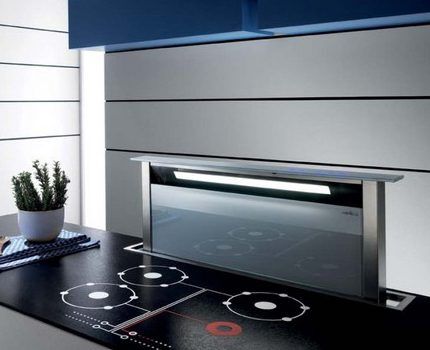
Types and design of hoods without outlet
The hood that purifies exhaust air differs from the usual one by the presence of an additional fine filter. And in some cases, the absence of an air duct. These devices are produced by the same companies that produce evacuation hood models. Moreover, one hood can have 2 modes at once - air extraction and air purification.
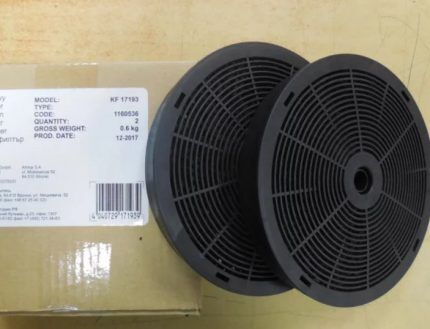
Such a device consists of the following parts:
- housing that houses the main operating components;
- control panels - it can be push-button or touch-sensitive;
- the motor responsible for the operation of the unit;
- coarse and fine filters - there can be 2 or more of them;
- plugs for connecting to the network;
- lighting lamps;
- It is possible to have an air duct if the model has an evacuation mode of operation.
Depending on the model, such a hood may have a different appearance, a different number of operating modes, and will differ in the number of speeds, power and quality of performance of its main functions.
Also, the cost of the unit can be from a couple of thousand to 20-40 thousand rubles or more.
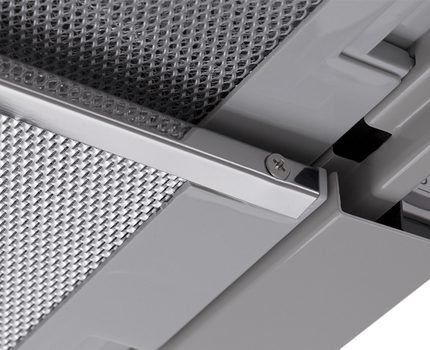
Air purification devices have one thing in common - the presence of an additional carbon filter and the ability to work without evacuating exhaust air. And the case material, its design, color and other features may be similar to models of exhaust devices from the same manufacturers.
Operating principle of the equipment
Equipment with fine filters operates in recycling. It does not require the installation of special channels to remove exhaust air containing impurities and tiny particles of fat and soot.
The essence of how such a hood works is that it draws polluted air inside its body. Along the way there is a grease filter, on which larger particles of fat, soot and other impurities found in the exhaust air remain.

Then comes the turn of the fine filter, in which the air is further purified from smaller particles. Some models have another carbon filter, which more delicately cleans the air that has passed through the grease and first carbon filters.
After cleaning, the air is returned back to the room. And a new portion of the waste gets back inside the equipment.
It turns out that the main role in the carbon device is played by filters. They differ in appearance - there are cassette systems and coal pillows. Most often, each model of hood uses its own carbon filter, but there are also universal ones that are suitable for many appliances.
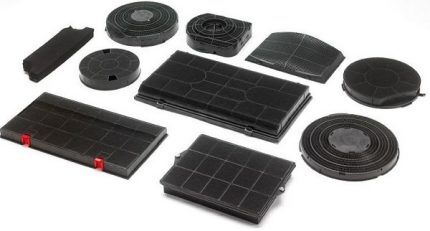
The carbon filter is made from various materials. This can be a disposable or reusable accessory. The main working component in it is the absorbent material – activated carbon. It happens:
- stone;
- peat;
- coconut;
- impregnated.
And the shape of the filter depends on the model and design of the hood. It can be round, rectangular, concave, flat, or in the form of a cassette of a couple of centimeters.
The service life of carbon filters depends on the frequency of switching on the hood and the duration of its operation. The more often this happens, the more often the filter will have to be changed. After all, when coal is filled with fat, soot and other impurities, the exhaust air practically does not pass through such a dirty filter. Accordingly, further cleaning is impossible without replacing or restoring the carbon accessory.
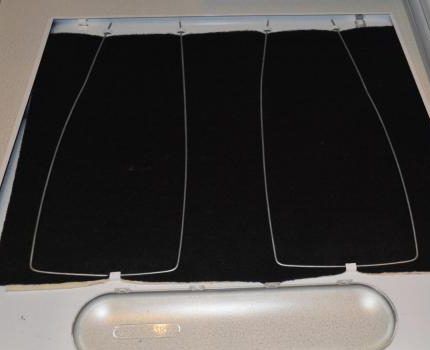
To slightly extend the performance of the carbon filter installed in the hood, manufacturers recommend turning on the equipment simultaneously with the start of the cooking process.
And turn it off only 5 minutes after turning off the stove/oven.

Rules for choosing a coal hood
In order for the equipment to efficiently perform its functions of cleaning the air from various odors, to serve for a long time and not to cause additional problems, you need to take the step of choosing a hood responsibly. The quality of life and microclimate in the serviced premises will depend on the chosen model and its features.

It is easy to get confused among the proposed options for coal hoods. Choosing the right model may not be so easy - they are all so different.
It is important to focus on the following characteristics:
- number of operating modes;
- required number of speeds;
- device power;
- noisiness;
- size;
- cost of a replacement carbon filter and availability;
- the cost of the hood itself.
When choosing, the main thing is to immediately decide how many operating modes are needed and how much money can be spent on the device. This can be only exhaust air purification or a cleaning mode and an evacuation mode. The number of speeds affects the noise and speed of exhaust air processing.

Then you have to choose the right power of the equipment. Here you will need the area of the room and the height of the ceilings. To correctly calculate the power, you need to multiply these 2 values together, then multiply by a correction factor of 1.3 and multiply by the number of air updates in the room per hour - for the kitchen this is 12. The resulting value will be the required power.
As for the noise level of the hood, for coal models, as well as for options with an air duct, you should adhere to a level of 40 dB. The range can be expanded to 50 dB if none of the family members suffer from increased irritability. It’s good if it’s a model with 3-5 speeds, then maximum noise will be observed only when operating at the highest speed.
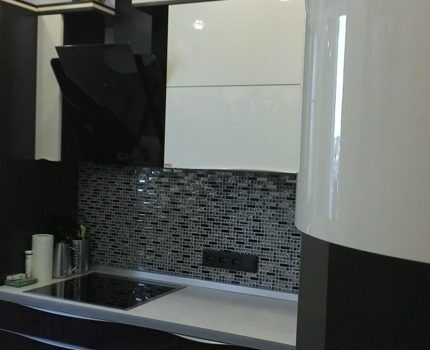
When choosing, the size of the air purification device in the kitchen plays an important role. Its width must be no less than the width of the slab. Ideally, the hood should be 10 cm wider than the stove. This will ensure optimal purification of the exhaust air.
The cost of replacement carbon filters when choosing a device is also important - especially if a new one costs about 2,500 rubles. Here it is worth thinking about the advisability of purchasing such a model.
You should also pay attention to the period of use of the fine filter recommended by the manufacturer.This could be 2-3 months, or 9-12 months. And in some cases, even 3 years when it comes to refurbishable Long Life accessories.
Moreover, not only the cost, but also the availability of the desired filter model in your region is important. After all, if you have to change it every 2 months, and wait 3-4 months for delivery to the service center, then you clearly need to pay attention to a different hood model.
When the selected equipment meets all the criteria that are individual for each user, you can safely purchase the model you like. The main thing is that its price is also suitable.
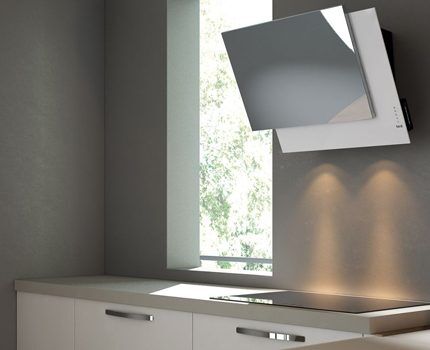
How to install the equipment correctly?
When installing a coal hood, all the rules apply as when installing equipment with an air duct. In addition, the location of the ventilation shaft will not matter here if the device does not have an evacuation mode.
Firstly, it is important to endure height from slab – at least 65 cm to the hood. Secondly, you will need an outlet to connect the device to the network. Thirdly, depending on the design features of the selected model, it will have to be installed correctly.
This could be installation in a kitchen cabinet niche or installation of a free-standing appliance. The manufacturer's instructions will detail how to install it correctly.
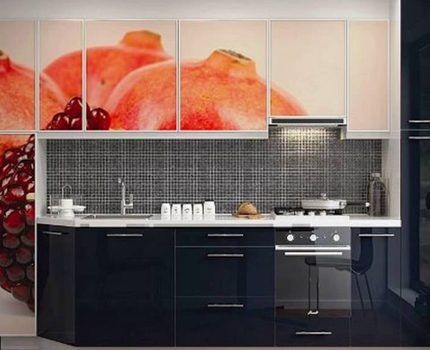
If this is a model with air exhaust and carbon filters, then, in addition to installation, you will also need connection to the ventilation system Houses.
Thus, the installation of a coal hood model will directly depend on its design and functional features. After the box has been correctly installed and secured, you will need to install a carbon filter, following the manufacturer’s recommendations.
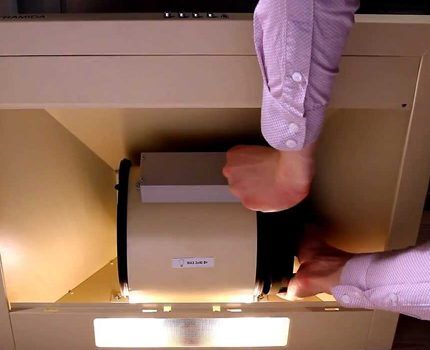
After installing fine filters, you need to install fatty - These are coarse filters that are the first to take the blow during operation.
When all installation work is completed, you can turn on the device to the electrical network and press the corresponding button on the control panel. This way you can check the operation of the hood, which will indicate that all installation work was carried out correctly.
Do you want to install a hood yourself without venting? In this case, go via this link and read detailed instructions for its installation.
Features of caring for coal hood
Coal exhaust air purification devices require preventive inspections and maintenance. When it gets dirty, you need to remove the grease filter and clean it. To do this, use the same detergent as for washing dishes. It is important that when servicing the hood, be sure to turn it off from the electrical network.
Also, if during a routine inspection it is discovered that one of the light bulbs has burned out, it is necessary to purchase a similar model of the same power.It is also necessary to install it only after turning off the device from the network.
Air purification equipment has its own characteristics, which consist in periodically changing carbon filters. The frequency of these manipulations depends on the model of the device, frequency of use and manufacturer’s recommendations. At the same time as servicing the grease filter, the carbon filter should also be inspected.
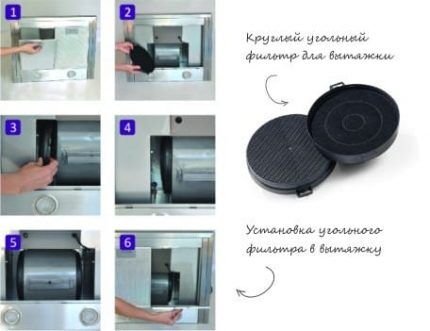
The carbon filter is located in the hood behind the coarse filter.
Can:
- purchase a spare filter from a service center;
- use a universal filter, giving it the required dimensions with scissors;
- clean the old one if it is a restored model;
- make your own carbon filter;
- replace the filler in the cassette filter model.
It all depends on the manufacturer’s recommendations, cost and availability of replacement carbon filters. So, if there are no problems with this, then it is easier and more convenient to purchase a ready-made accessory. Otherwise, the problem can be solved on your own.
To make a replacement filter, you will need sheet synthetic polyester, scissors and activated carbon in granules or tablets.
Then, between 2 layers of synthetic padding, you need to place granular absorbent filler and carefully fix everything in the cassette.
In some filter models, the protective fabric layer can be carefully removed and washed - after these procedures it does not lose its properties and can be reused.
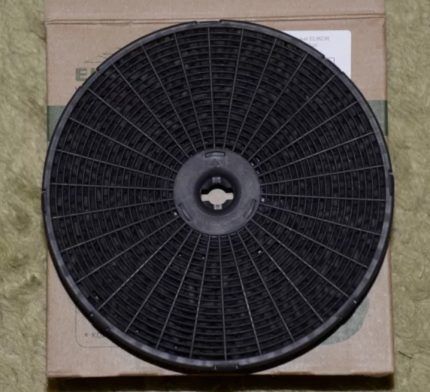
You should read the instructions supplied by the manufacturer about the capabilities of your filter model. For example, there are wonderful carbon filters that can last 3 years. These are refurbishable accessories from Elica called Long Life. When they become dirty, they are washed, dried and put back in place.
The service life of different manufacturers and models of accessories may vary significantly.
It also directly depends on the intensity of use of the carbon hood - the less often it is turned on, the longer the filter will last:
- Elica, in addition to Long Life filters, has an average lifespan of 2 months;
- for Elikor, Falmec, Jetair it is 3-4 months;
- for Fabriano and Gaggenau - 6 months on average;
- and filters from Krona and Bosch have a service life of 12 months.
As for the cost, it ranges from 250 to 3000 rubles per accessory. Therefore, it is important to take care of a spare carbon filter in advance so that it is at hand at the right time.
Conclusions and useful video on the topic
Sometimes it is easier to restore a carbon filter yourself than to purchase an equivalent replacement. The video will demonstrate how to revive the fine filter:
Depending on the model of the hood, the process of installing a carbon filter in it will also differ. Moreover, it can work both with air exhaust and in recirculation mode, if you additionally install a carbon filter:
About choosing the optimal hood (part 1):
Tips for choosing a hood (part 2):
Having become more familiar with the features of hoods that can operate in recirculation mode, you can choose the best option for your kitchen. Moreover, the price range is quite wide - there are both modest coal models and expensive ones for several tens of thousands of rubles.
Excellent performance characteristics, ease of maintenance, the ability to install and replace filters with your own hands make hoods with fine filters desirable assistants in any kitchen.
Are you thinking about buying a hood with a carbon filter and want to consult with our experts and other site visitors? Or are you ready to share your experience in choosing and operating such equipment? Leave your questions, write reviews about the pros and cons of your model, add a photo of your coal hood, indicate your opinion about this equipment below the article.
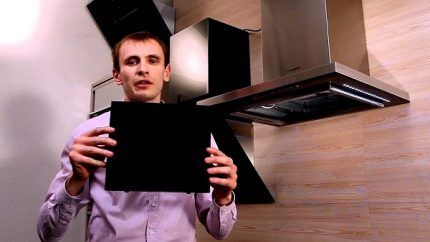




My wife has been dreaming of a range hood for a long time, but installing it in our apartment is very problematic. The design flaw is that there is no ventilation shaft. But a hood with a carbon filter can be a real way out of the situation. They probably appeared recently; I didn’t know about them before. And now I’m studying offers in online stores. I've even looked at the Kaiser brand. Every dog has his day.
Curious, why not Krona or Elikor?
If the mounting base for a built-in hood (you wrote about such a model?) is 600 mm, then the main thing is that it be equipped with two motors. At 500 mm, these two manufacturers do not have dual-motor hoods, unless they have released some new products. In fact, there are no other differences - their performance, plus or minus a kilometer, is identical.
Only the 40 mm high panel remains visible, and the motor unit goes into the kitchen cabinet. The noise level may differ slightly, and control options: old slider, push-button, touch... and with Swarovski crystals for hipsters =) Krona had such a model back in 2010.
The main thing that needs to be taken into account is that the motor part is fixed tightly to the horizontal tie of the furniture cabinet. Even if you do not use a corrugated outlet for forced exhaust, you will need to make a hole in this screed above the valve (usually it is shifted to the rear edge of the hood, and does not run through the center, as many are mistaken). If such a hole is not provided, then air will not be recirculated and the equipment will fail. It will burn if in Russian.
I would say that the cost and ease of availability of these very carbon filters should be paid attention first. Well, also the extraction power. Everything else is lyrics.
Good afternoon, I beg you to help me, I’ve already tormented everyone with questions, but no one can give an answer. Built-in telescopic hood with recirculation and carbon filter, kitchen to the ceiling, I want to understand how to install it inside the cabinet.
What's going on there?) How does the air get back into the room? Through what? Doesn't moisture and heat remain in the cabinet and damage the chipboard facades? Or do I need to mount a grille like a fireplace type in the façade of the top cabinet and some kind of metal box and a pipe from the hood or just a grille? Thanks in advance for your answer.
Good afternoon, Irina.
The passport of your hood must contain a section “Installation”, which provides diagrams for the “organization of paths” for the return of purified air - I recommend working through it. If you don’t have a passport, look at screenshot No. 1 to the comment, which gives a general idea of the air recirculation scheme.
Your choice of hanging cabinets will likely require upgrading the front of the cabinet with a built-in hood - cutting through the front wall and installing a decorative grille. An air duct may also be required.